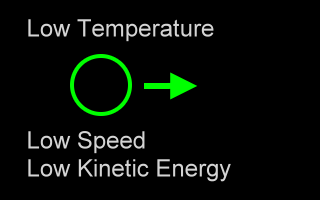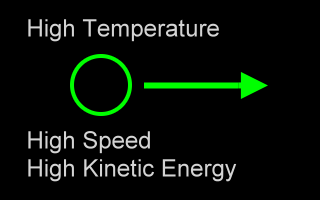Gas Molecule Motion
At a low temperature a gas molecule travels, on the average, at a slower speed than than it would at a high temperature. So, at a low temperature the molecules have, on the average, less kinetic energy than they do at a high temperature. Lower speeds, lower kinetic energies. If we imagine a gas molecule as a green circle:


Temperature, when measured in Kelvin degrees, is a number that is directly proportional to the average kinetic energy of the molecules in a substance. So, when the molecules of a substance have a small average kinetic energy, then the temperature of the substance is low. And large average kinetic energy means the temperature is high. Remembering that the lower case Greek letter alpha (α) means 'is directly proportional to', in symbols we have:
T α KEave
In the following animation gas molecules are modeled as little circles. They are bouncing around in two sealed containers.
The left container shows all of the gas molecules traveling at the same speed. This is not a perfect representation of their motion. Actually, these gas molecules would all travel at different speeds, and so all have different kinetic energies.
However, for any temperature there is an average kinetic energy and a corresponding average speed for the motion of these molecules. This animation visualizes the molecules to be traveling at this average speed.
The right container works the same way, but at a higher average speed.
Lower Temperature |
Higher Temperature |
The right container's molecules are at a higher temperature than those on the left. Compare their speeds carefully. The ones on the right are faster. These are faster by a factor of the square root of two, 1.414. This makes the average kinetic energy of these molecules to be twice that of those to the right, since the kinetic energy of a body is proportional to the square of the speed of the body. Consequently, this right container represents a gas at twice the Kelvin temperature than the gas in the container on the left.
The area of the right container (higher temperature) is twice as large as the area of the left container (lower container) so that the pressure of the gas is properly simulated as being equal in both. This allows us to properly visualize the effect of a temperature change on the speed of gas molecules without concerns about other effects due to pressure changes.
What you should notice in the right container is that the higher temperature is tied to a higher average speed. This results in the molecules having a higher average kinetic energy.
In the right container there is an increase in the kinetic energies of the molecules due to an input of heat. Why are those molecules on the right going faster than those on the left? Well, we could imagine that they were once going the same speed as those on the left and then they received an input of heat (energy). After the heat input, they move faster.
Heat, as stated earlier, is energy. If the kinetic energies of the molecules go up, then the heat (energy) within the gas has gone up. Therefore, we see an input of heat can cause an increase in temperature because the input of heat is realized as an increase in the kinetic energies of the gas molecules. When the average kinetic energy of the gas molecules goes up, the temperature goes up. Heat goes into a substance, the temperature goes up - that's one way it can work.
An input of heat is not always accompanied by an increase in temperature, however. That is very important to understand. The heat (energy) could be used to change the bonding between the molecules rather than be used to speed up the molecules. This would be a situation where heat goes into a substance, and the temperature does not rise, as when ice melts or water boils. In these cases the increase in heat (energy) is used to change bonding between the molecules rather than change their kinetic energies.